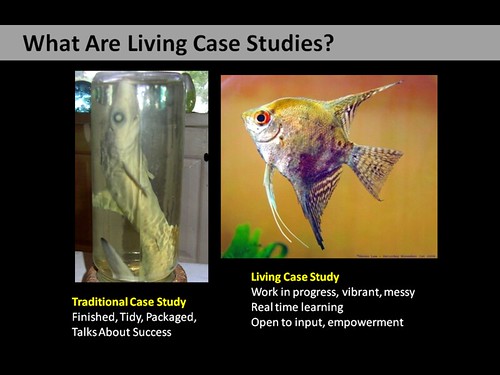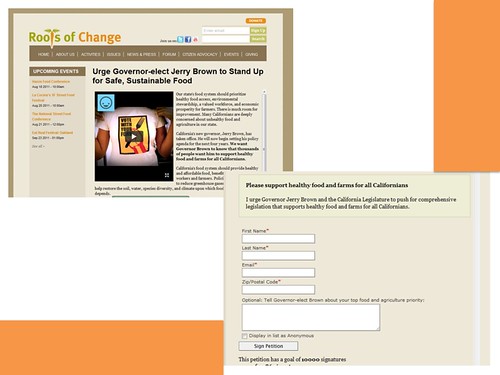As part of my work this year as Visiting Scholar at the David and Lucile Packard Foundation, I’m designing and delivering peer training sessions for grantees all around the theme of social media, learning, and measurement. This year I’m more of a guide on the side and helping to surface the knowledge and experience in the room. This approach produces rich learning. This week I did a social media training for a cluster of the foundation’s sustainable agriculture grantees. Here’s some notes on what I learned integrated social media campaigns as well as the process that prompted these insights.
1. Spectragram
Spectragram is a facilitation technique I learned from Allen Gunner at Aspiration. You have people line up in the room based on whether they agree or disagree with a statement. This is an easy way to get people moving around and wake up, especially if your session is at the end of the day. More importantly, it unpacks any skepticism or opposing points of view about the topic you’ll be addressing in the peer learning. It is a good idea to include a fun question appropriate to the audience to illustrate the technique. We used: I love grass-fed beef
I used the following statements given that I had a mix of staff members – from executive directors, social media managers, and policy/program directors.
You can explain complex issues like cap and trade in 140 characters
Policymakers do not pay attention to messaging that comes through social media channels
These statements prompted some rich insights. I learned that you can’t explain complex, wonky policy positions in 140 characters, but you could communicate or let people know the policy paper exists with a punchy statement and pointer to the paper.
2. Living Case Study

I use a “Living Case Study” technique — it is less formal that your traditional case study because it covers a work in progress and shares lessons learned as well as successes. Often, they’re messy, but vibrant and all about real time learning. While the traditional case study is tidy, packaged, and finished – the living case study is open to input, questions, reflections and most of all empowerment of peers. Erika Croxton from Grist and Daniela Aceves from Roots of Change agreed to each share a living case study.
I worked with both to prepare an ignite style presentation that shared a specific campaign or project that incorporated social media. Both answered the same set of reflective questions, carefully crafted to extract wisdom. The ignite style presentation is brief – no more than 7 minutes and forces a particular discipline on being visual, brief, and engaging. Following the presentation, I provided feedback on best practices and how to extend them – then asked questions to kick off a group discussion.
Here’s some of the insights generated in the session.
Ladder of Engagement

Grist shared a simplified version of their ladder of engagement of how they move people from passive to active participation. Having a well-thought out ladder of engagement (or marketing funnel or more recently “a decision journey“) is critical to the success of a communications campaign that integrates social media. This helps your organization think through messaging and tactics to get people to the next stage on the ladder and identify key metrics to measure how effective those tactics are.
Experimenting to Expand Capacity

The Grist living case study illustrated how they started off with agile pilots just to test the waters – in this case – how to effectively use Twitter hashtags to drive traffic and discussion on their site. They measured and learned from the first pilot which was rapid implementation. The next pilot, they became more intentional in strategy – still using listen, learn, and adapt approach. What I found most interesting, is how they used measurement to expand capacity. Prior to having a dedicated person working on social media, they integrated social media into all staff job descriptions and tracked how a small amount of time invested could get results. This gave them the confidence to invest in a dedicated staff.
How To Convince Policy Directors
One question we got from the group was from Jimmy Daukas from the American Farmland Trust, “How do you get people who work on the program or policy side of the organization to be excited about social media and willing to experiment?” He was willing to do this brief interview about how to convince someone like him – the managing director who works on the policy side – to be open to social media. His take: More conversation between the communications and policy staff about the potential of social media to get results, especially hearing case studies from other organizations.
Building Networks of Partners
Roots of Change talked about how they always work with other organizational partners to cross fertilize or build movements around their policy change ideas. This is a hallmark of Networked Nonprofits. One of the ways they are doing this with the above video about the food movement. You’ll see a list of partnering organizations on the end. They’ve had several versions of this video created – each with a group of different partners. Working with partners extends their work in a networked way – that ends up being efficient. And by customizing the last few frames of the video, they can inexpensively re-purpose materials to encourage a networked approach.
A/B Testing

Roots of Change worked with Change>org to implement this petition. They discovered that Change.org was not just a platform, but there was a community of activists standing ready to spread their campaign. They used the landing page as a hotbed for A/B testing – analyzing what worked best to get conversion — images, less or more text, placement of “sign petition” button and so forth. They learned that images are really key for conversion. More detailed suggestions for A/B testing with images here.
Leadership and Social Media: Reverse Mentoring, Empowering Millennials, and CEO Tweets
The presenter for Roots of Change was Daniela Aceves, a millennial who is responsible for the social media at her organization. Often, we hear from Millennials who are working inside of nonprofits that they aren’t empowered. In this case, Roots of Change executive director Michael Dimock has done an admirable job empowering younger staff and reverse mentoring. (If you want a terrific example of how an executive director can use Twitter, check out Michael’s Twitter stream for a well-curated stream of food policy information. Also, check out Bruce Lesley from First Focus, a child advocacy organization, who has also mastered the art of curating and sharing quality links related to the organization’s mission.
3. Reflections
Being a “Guide on the Side” versus “Sage on the Stage” produces richer, more engaging peer learning. Some questions for all of you:
What’s your ladder of engagement for integrated communications campaigns? How do you measure each rung along the ladder?
Have you used measurement to make the case for building social media capacity?
How does your organization use A/B testing to improve conversion rates?
If your organization works on policy, how have you convinced leadership (or not) to embrace social media?
Update: Melanie Janin of BSR writes about why sharing a messy case study is important. Here’s why it is important to share it as you go:
- Others have been there, done that. Learn from others who have faced the same challenges. If you ask for help to solve a particular challenge that’s keeping you up at night, you just might get it.
- Social media loves social inquiry. Pose your challenges publicly through social media channels. Start a blog tracking your sustainability efforts. See who responds and engages. They might just become your next biggest advocate—or most loyal consumer.
- True leaders have the guts to reach out and engage. As we explored in our recent BSR Report, leadership today is no longer equated with top-down, didactic messaging and communications. Include multiple voices into your platform for impact and change. The more you share, the more you stand to gain from the perspective of others.
